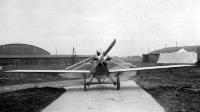JD-2 Prewar innovation on WUT
In December 1925 the Aviation Section of Mechanical Scientific Organization of Warsaw University of Technology created the first aviation workshop. It took place in the underground of a New Drawing Office (Nowa Kreślarnia), however a montage went on in a gate of Chemistry Edifice of WUT. This is the place, where the first sport aircraft JD-2 was created.
Jerzy Drzewiecki started studies on the 1st of October 1921. As a student he became a member of Warsaw Academic Aero Club, where he got his professional aeronautical training.
Rector of Academy of Fine Arts, professor Jan Pruszkowski, who were the head of Aero Club at that time, dubbed him an aviator.
According to the custom, a young pilot had been given the aviation crest “Bysio”, which presented a bullhead fire breathing. The first machine created by Drzewiecki was a glider, in 1924. One year later as a member of Aviation Section of Mechanical Scientific Organization of Warsaw University of Technology he designed his first engine drive airplane – JD – 2, called after initials of its constructor.
Handmade plane
JD-2 was a second project created by Drzewiecki. Two Anzani engines (45hp) were given to the Aviation Section of Mechanical Scientific Organization of Warsaw University of Technology at the end of 1924. When in 1925 Drzewiecki joined the section he immediately started his work on the plane that would be compatible with the engine. The situation was an inspiration for Drzewiecki. He knew that all he could use were only commonly used materials and that everything he did must have been handmade.
A prototype JD-2 called after its constructor was created under the direction of Antoni Kocjan in 1926.The basis of two seated plane was a wooden construction. Metal elements were made by aviation manufactures: PWS and CWL. All necessary test were conducted in a lately created Aviation Institute of Technical Researches (currently Aviation Institute).
The first who tested this plane was lieutenant d’aviation Kazimierz Kalina who had the first flight over the Mokotów airport. The flight ended up tragically. The plane caught fire during landing because of the bad localization of fuel lines. Wounded pilot was transferred to the hospital, but it was not the end of the history of JD-2. At the end the testing pilot provided a positive opinion concerning the plane so the work on another models could have been launched.
Another constructions
The next JD-2 won a first prize in a First National Puddle Jumpers Contest in October 1927. In years 1929-1930 the Aviation Section of Mechanical Scientific Organization of Warsaw University of Technology built another four planes - JD-2bis.
The first sport plane called RWD-1 – after the names of its creators: Jerzy Drzewiecki, Stanisław Rogalski, Stanisław Wigura was being built for about a year from 1927 to 1928. RWD-1 took a second place in a Second National Puddle Jumpers Contest for the original construction. Based on this success the long cooperation started between Rogalski, Wigura i Drzewiecki.
Experimental Aviation Workshops
On the 9th of December 1929, Jerzy Drzewiecki finished his first level of studies on Faculty of Engineering. Workshops of Aviation Section had been moved from Warsaw University of Technology to Okęcie in 1930 to convert into Experimental Aviation Workshops Copartnership after another three years.
Drzewiecki was the main constructor of DWL. He also tested prototypes of planes. When testing RWD - 6 he had an accident – wings teared, but luckily the pilot was only barely injured.
RWD-7, on the other hand, was the plane that beaten an international speed record. Drzewiecki and Wędrychowski reached speed of 178 km/h, and Drzewiecki and Kocjan reached 6023 m.
Together 314 RWD planes were built in Experimental Aviation Workshops and DWL from 1926 to 1939. Another 540 were built in other manufacturer in Poland and abroad. Estonia and Yugoslavia produced about 850 planes. RWD-8 planes were a basic gear of the Polish Sport and Military Aviation in the thirties. Most pilots who took part in the World War II were training on the planes, created based on ideas of Jerzy Drzewiecki.
From Warsaw University of Technology to movies
LD-2 was sensitive to wind. At high speed it used to spin, that is why a pilot who trained on more stable plane could experience problems while navigating Drzewiecki’s plane.
During the thirties the construction couldn’t compete any more with new designed planes. One of the old planes was bought by famous pilot – Zbigniew Babiński, who renovated it and used it for pleasure flights.
The names of cities where LD-2 had landed were written on the hull. During summer of 1937 the same model was used in a movie “A girl who is looking for love”.
Monika Bukowska
_________________
Based on:
Jak feniks z popiołów – niezwykła historia JD-2, http://ilot90.pl/jd-2/, dostęp: 01.03.2016.
Jerzy Drzewiecki – konstruktor, który uskrzydlił Polskę, http://www.polskieradio.pl/39/156/Artykul/1441853,Jerzy-Drzewiecki-konstruktor-ktory-uskrzydlil-Polske, dostęp: 01.03.2016
Samolotypolskie.pl, http://www.samolotypolskie.pl/samoloty/882/126/Drzewiecki-Jerzy-Jan2, dostęp 01.03.2016.








